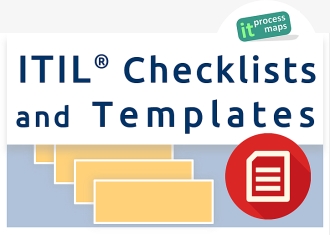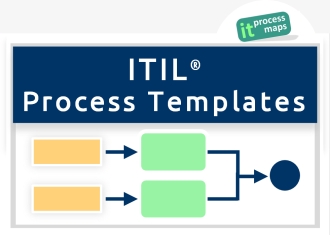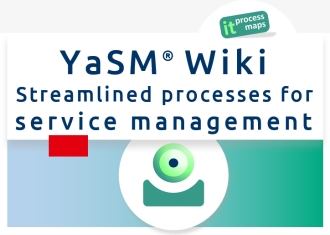Service Asset and Configuration Management: Difference between revisions
No edit summary |
mNo edit summary |
||
| Line 1: | Line 1: | ||
<imagemap> | |||
Image:ITIL-Wiki-de-es.jpg|DE - ES - Service Asset and Configuration Management|100px | |||
rect 0 0 50 30 [https://wiki.de.it-processmaps.com/index.php/Service_Asset_and_Configuration_Management diese Seite auf Deutsch] | |||
rect 50 0 100 30 [https://wiki.es.it-processmaps.com/index.php/ITIL_Activos_de_Servicio_y_Gestion_de_la_Configuracion esta página en español] | |||
desc none | |||
</imagemap> | |||
<br style="clear:both;"/> | |||
== ITIL Service Asset and Configuration Management: Overview == | |||
'''Process Objective''': To maintain information about Configuration Items required to deliver an IT service, including their relationships | '''Process Objective''': To maintain information about Configuration Items required to deliver an IT service, including their relationships. | ||
'''Part of''': [[ITIL V3 Service Transition|Service Transition]] | '''Part of''': [[ITIL V3 Service Transition|Service Transition]] | ||
'''Process Owner''': [[ | '''Process Owner''': [[Service Asset and Configuration Management#ITIL Roles in Service Asset and Configuration Management|Configuration Manager]] | ||
==ITIL | == ITIL Service Asset and Configuration Management: Process Definition == | ||
[[Image:Service-asset-and-configuration-management.jpg|thumb=Overview_service_asset_configuration_management_itilv3_thumb.jpg|left|[https://wiki.en.it-processmaps.com/images/pdf/process_overview_service_asset_configuration_management_itilv3.pdf Service Asset & Configuration Management]]] | |||
Activities and process objectives of the Service Asset and Configuration Management process are broadly identical in ITIL V3 and V2. ITIL V3 introduces the "Configuration Management System ([[Service Asset and Configuration Management#CMS CMDB|CMS]])" as a logical data model, encompassing several Configuration Management Databases ([[Service Asset and Configuration Management#CMS CMDB|CMDB]]). | |||
The following sub-processes are part of [[Service Asset and Configuration Management|Service Asset and Configuration Management]]: | |||
<br style="clear:both;"/> | |||
=== Sub-Processes === | |||
;Configuration Management Support | ;Configuration Management Support | ||
:Process Objective: To define and update the CMS structure in such a way that it can hold the required information related to CIs, including their attributes and relationships. | :Process Objective: To define and update the [[Service Asset and Configuration Management#Change Request to CMS Structure|CMS structure]] in such a way that it can hold the required information related to CIs, including their attributes and relationships. | ||
;Configuration Verification and Audit | ;Configuration Verification and Audit | ||
:Process Objective: To perform regular checks, ensuring that the information contained in the CMS is an exact representation of the CIs actually installed in the live production environment. | :Process Objective: To perform regular checks, ensuring that the information contained in the CMS is an exact representation of the CIs actually installed in the live production environment. | ||
< | |||
===== Downloads ===== | |||
Use the following links to open the process overview of Service Asset and Configuration Management showing the most important interfaces: | |||
* [[Media:Service-asset-and-configuration-management.jpg|Service Asset and Configuration Management (.JPG)]] | |||
* [https://wiki.en.it-processmaps.com/images/pdf/process_overview_service_asset_configuration_management_itilv3.pdf Service Asset and Configuration Management (.PDF)]'' | |||
=== ITIL Terms: Service Asset and Configuration Management === | |||
;<span id="Change Request to CMS Structure">Change Request to CMS Structure</span> | |||
:A request from a Service Management process to change the CMS structure. This request is sent to Configuration Management if new CIs or attributes must be recorded but the CMS's structure is not adequate for holding the new data. | |||
;<span id="CMS CMDB">CMS/ CMDB</span> | |||
:The Configuration Management System (CMS) is a coherent logical model of the IT organization’s infrastructure, typically made up of several Configuration Management Databases (CMDBs) as physical sub-systems. It is used to store information on all Configuration Items (CIs) under the control of Configuration Management (see also: [[Checklist CMS CMDB|ITIL Checklist CMS - CMDB]]). | |||
;<span id="CMS Change Policy">CMS Change Policy</span> | |||
:A set of rules defining who is authorized to modify the structure and contents of the CMS. | |||
;<span id="Configuration Audit Report">Configuration Audit Report</span> | |||
:A report summarizing the results of a CMS audit, highlighting revealed differences between CMS records and actually installed CIs. | |||
;<span id="DML">Definitive Media Library (DML)</span> | |||
:One or more locations in which the definitive and approved versions of all software Configuration Items are securely stored. The DML may also contain associated CIs such as licenses and documentation. | |||
:DML is a single logical storage area even if there are multiple locations. All software in the DML is under the control of Change and Release Management and is recorded in the Configuration Management System. Only software from the DML is acceptable for use in a Release. | |||
== Additional Information on Service Asset and Configuration Management == | |||
==== ITIL KPIs and Checklists ==== | |||
* [[ITIL KPIs Service Transition#ITIL KPIs Service Asset and Configuration Management|Key Performance Indicators (KPIs) Service Asset and Configuration Management]] | |||
* [[Checklist CMS CMDB|Checklists Service Asset and Configuration Management: CMS/ CMDB]] (Configuration Management System/ Configuration Management Database) | |||
==== ITIL Roles in Service Asset and Configuration Management ==== | |||
;Configuration Manager - Process Owner | |||
:The Configuration Manager is responsible for maintaining information about Configuration Items required to deliver IT services. | |||
:To this end he maintains a logical model, containing the components of the IT infrastructure (CIs) and their associations. | |||
<i><small>[[Main Page|Home]] > [[ITIL Processes]] > [[ITIL V3 Service Transition|Service Transition]] > [[Service Asset and Configuration Management|Service Asset and Configuration Management]]</small></i> | |||
<!-- This page is assigned to the following categories: --> | |||
[[Category:ITIL V3]][[Category:ITIL process]][[Category:Service Transition|Service Asset & Configuration Management]][[Category:Service Asset & Configuration Management|!]] | |||
<!-- --- --> | |||
Revision as of 11:32, 13 July 2011

ITIL Service Asset and Configuration Management: Overview
Process Objective: To maintain information about Configuration Items required to deliver an IT service, including their relationships.
Part of: Service Transition
Process Owner: Configuration Manager
ITIL Service Asset and Configuration Management: Process Definition

Activities and process objectives of the Service Asset and Configuration Management process are broadly identical in ITIL V3 and V2. ITIL V3 introduces the "Configuration Management System (CMS)" as a logical data model, encompassing several Configuration Management Databases (CMDB).
The following sub-processes are part of Service Asset and Configuration Management:
Sub-Processes
- Configuration Management Support
- Process Objective: To define and update the CMS structure in such a way that it can hold the required information related to CIs, including their attributes and relationships.
- Configuration Verification and Audit
- Process Objective: To perform regular checks, ensuring that the information contained in the CMS is an exact representation of the CIs actually installed in the live production environment.
Downloads
Use the following links to open the process overview of Service Asset and Configuration Management showing the most important interfaces:
ITIL Terms: Service Asset and Configuration Management
- Change Request to CMS Structure
- A request from a Service Management process to change the CMS structure. This request is sent to Configuration Management if new CIs or attributes must be recorded but the CMS's structure is not adequate for holding the new data.
- CMS/ CMDB
- The Configuration Management System (CMS) is a coherent logical model of the IT organization’s infrastructure, typically made up of several Configuration Management Databases (CMDBs) as physical sub-systems. It is used to store information on all Configuration Items (CIs) under the control of Configuration Management (see also: ITIL Checklist CMS - CMDB).
- CMS Change Policy
- A set of rules defining who is authorized to modify the structure and contents of the CMS.
- Configuration Audit Report
- A report summarizing the results of a CMS audit, highlighting revealed differences between CMS records and actually installed CIs.
- Definitive Media Library (DML)
- One or more locations in which the definitive and approved versions of all software Configuration Items are securely stored. The DML may also contain associated CIs such as licenses and documentation.
- DML is a single logical storage area even if there are multiple locations. All software in the DML is under the control of Change and Release Management and is recorded in the Configuration Management System. Only software from the DML is acceptable for use in a Release.
Additional Information on Service Asset and Configuration Management
ITIL KPIs and Checklists
- Key Performance Indicators (KPIs) Service Asset and Configuration Management
- Checklists Service Asset and Configuration Management: CMS/ CMDB (Configuration Management System/ Configuration Management Database)
ITIL Roles in Service Asset and Configuration Management
- Configuration Manager - Process Owner
- The Configuration Manager is responsible for maintaining information about Configuration Items required to deliver IT services.
- To this end he maintains a logical model, containing the components of the IT infrastructure (CIs) and their associations.
Home > ITIL Processes > Service Transition > Service Asset and Configuration Management






